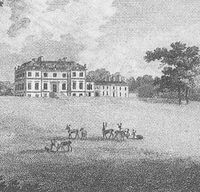Annotation:Mrs. Oswald of Auchincruive (1)
Back to Mrs. Oswald of Auchincruive (1)
MRS. OSWALD OF AUCHINCRUIVE [1]. Scottish, Reel. G Major. Standard tuning (fiddle). AAB. There are two possible persons who he may have referred to in his title. The first was Mary Ramsay, the daughter of the richest Scottish planters in Jamaica, who became the wife of Richard Oswald in 1750, son of a Caithness Kirk minister, a merchant in London, and commissioner in Paris for the peace negotiations that concluded the American War of Independence. He bought the estate of Auchincruive, St. Quivox, Ayrshire (along with tens of thousands of acres), in 1764, extended it, and filled it with works of art, in part with money he made from the slave trade. Oswald, working in the consortium Oswald, Boyd and Grant, owned a slave castle at Bance Island off the coast of Sierra Leone and was responsible for sending over 13,000 blacks to the southern colonies of America. The castle was "complete with a golf course serviced by tartan-clad African caddies" [1]). Later he profited from trade in the American War of Independence, earning the scorn of poet Robert Burns, but Benjamin Franklin rather liked him and Oswald had about him "an air of great simplicity and honesty". After his death in 1784, his widow Mary remained at Auchincruive until her death in London in 1788. She had been reviled locally for her tight-fisted ways with money. She was anathema to Burns, who described her as a "venerable votary of iron avarice and sordid pride," and that she was "detested with the most heartfelt cordiality" by her tenants and servants. He called her 'the Priestess of Mammon (the God of Riches)' and wrote a scathing satire after her death in 1789, meant to be anonymous, although the secret did not keep for long. It begins:
Ode, sacred to the memory of Mrs Oswald of Auchencruive
Dweller in yon dungeon dark,
Hangman of creation, mark!
Who in widow-weeds appears,
Laden with unhonoured years,
Noosing with care a bursting purse,
Baited with many a deadly curse?

On Mary's death the estate then passed to their son, Richard Alexander Oswald (1771-1841), a Member of Parliament. In 1793 Richard married the "incomparable" Louisa "Lucy" Johnston (c. 1760-1797), daughter of Wynne Johnston of Hilton-in-the-Merse, a celebrated and accomplished beauty (for whom see note for “Miss Johnston of Hilton's Fancy”) whose portrait was painted by Sir Henry Raeburn, and for whom Robert Burns wrote a song, "O, Wat ye Wha’s in Yon Town."
Lucy Johnston was a composer of tunes who had some of her works published by the Gows. The contents of James Johnson's Scots Musical Museum, referenced by William Stenhouse, credits Lucy as the composer of the melody for the song "O Mary! Dear Departed Shade", an elegy to Mary Ramsay. Robert Burns, writes Stenhouse (Illustrations of the lyric poetry and music of Scotland, 1853, pp. 318-319), "celebrated her in a song of less merit than usual: according to Dryden,
Whate'er she did was done with so much ease,
In her alone 'twas natural to please;
Her motions all accompanied with grace;
And Paradise was open'd in her face.
"None who ever had the delight of seeing her in the ball-room, giving double charms to a minuet, or dignifying a country-dance, can question the truth of this feeble encomium."--(C.K.S.)" [Charles K. Sharpe].
Source for notated version:
Printed sources: Stewart-Robertson (The Athole Collection), 1884; p. 182.
Recorded sources:
